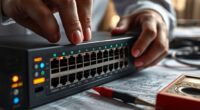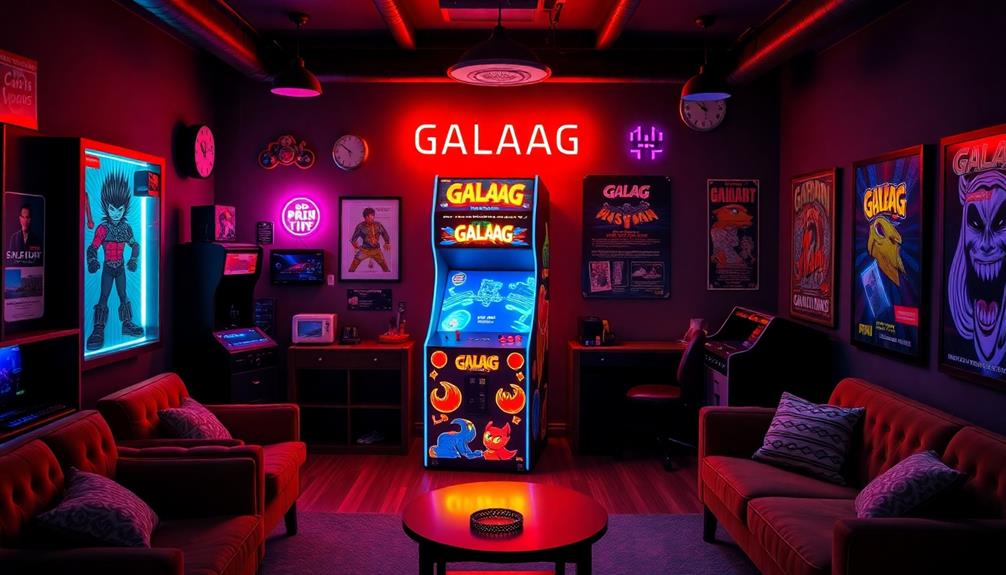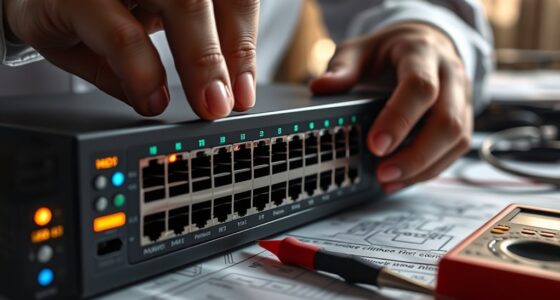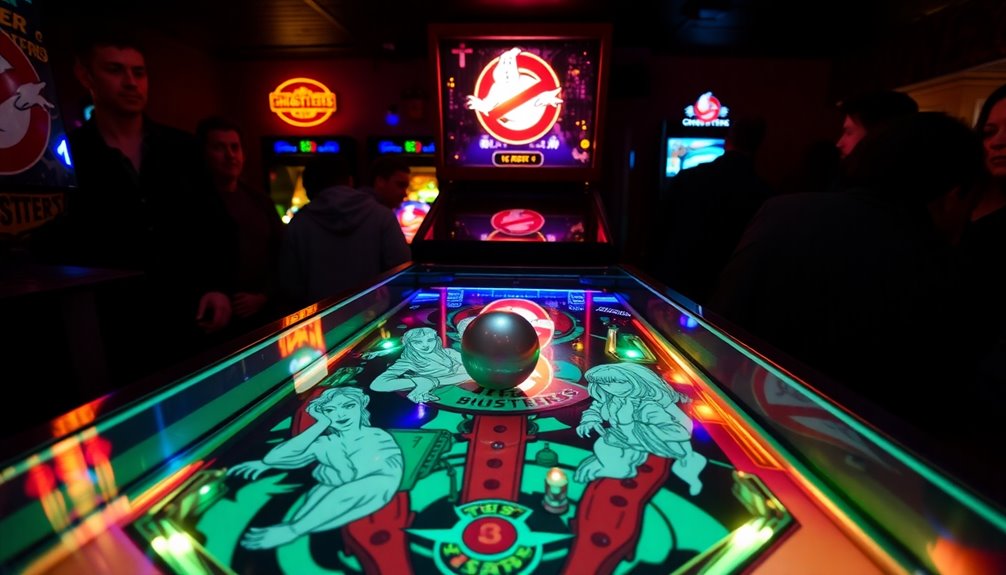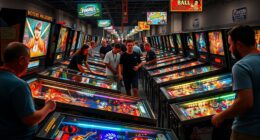Homebrew pinball machines are making a strong comeback as enthusiasts blend technology, artistry, and creativity to build personalized and innovative games. Using microcontrollers, custom artwork, and modern features like LED lighting and touchscreens, hobbyists push the boundaries of traditional design. Community support, online resources, and workshops help overcome challenges and inspire new ideas. If you’re curious about how this movement is evolving and shaping the industry, you’ll find plenty of exciting details ahead.
Key Takeaways
- The resurgence is driven by passionate hobbyists blending art and technology to create custom, sophisticated pinball machines.
- Online communities and workshops foster collaboration, resource sharing, and skill development for homebrew projects.
- Modern tools like microcontrollers, LEDs, and digital displays enable innovative gameplay and artistic designs.
- Challenges such as sourcing components and wiring are addressed through community support and detailed tutorials.
- The movement influences mainstream industry trends, inspiring more personalization and creative expression in commercial pinball machines.
The History and Evolution of Homebrew Pinball
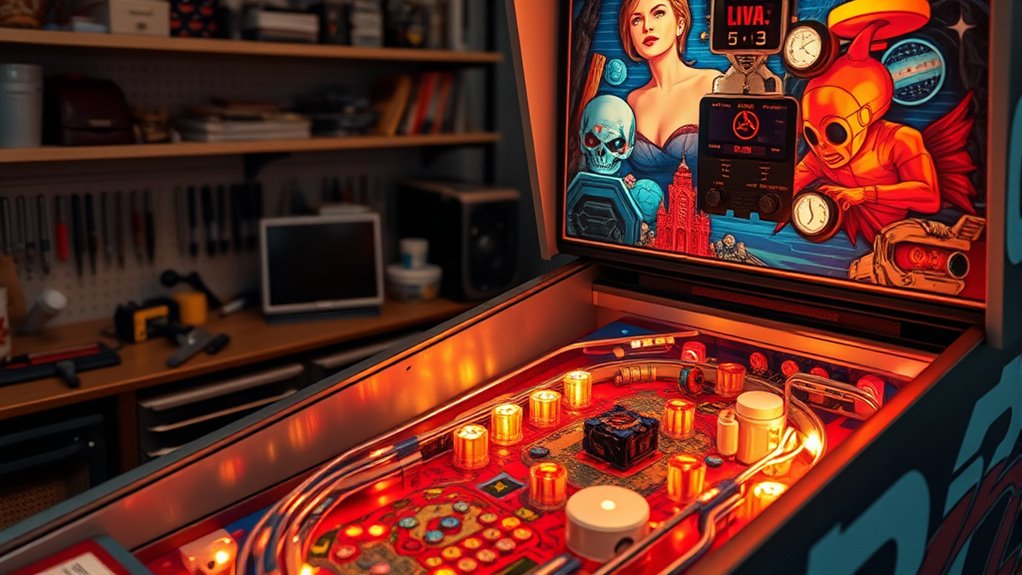
Have you ever wondered how homebrew pinball machines evolved from simple DIY projects to sophisticated creations? Early enthusiasts focused on basic mechanics, but as craftsmanship improved, custom artwork became a key feature, transforming the visual appeal of these machines. Sound design also played a major role, adding immersive audio effects that heightened gameplay experience. Over time, hobbyists experimented with electronics, integrating custom lighting, sensors, and even digital displays. This evolution allowed for more personalized themes and complex rules, setting homebrew pinball apart from commercial models. Additionally, understanding IRA investment strategies can inspire hobbyists to fund future projects or upgrade existing machines. Today’s creators blend artistry with technology, pushing the boundaries of what homemade machines can achieve. This rich history of innovation reflects a passionate community dedicated to reviving and reimagining the classic arcade game.
Key Components and Technologies Used in DIY Pinball Builds
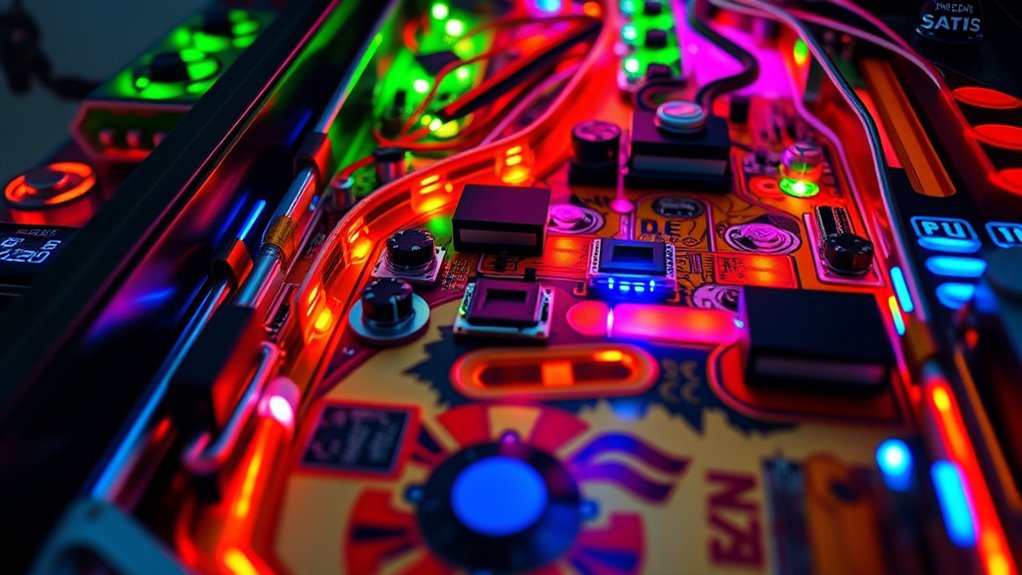
To build your own pinball machine, you’ll need to understand the key components that make it work. Microcontrollers and control boards handle the game logic, while mechanical and electronic parts bring the playfield to life. Software and programming tools allow you to customize gameplay and troubleshoot your creation effectively. Recognizing angel numbers can also provide spiritual guidance during your project.
Microcontrollers and Control Boards
Microcontrollers and control boards are the backbone of DIY pinball machines, managing everything from flipper actions to lighting effects. They enable custom control by allowing you to program specific responses for different game events, making each build unique. Microcontroller integration simplifies connecting sensors, switches, and displays, giving you centralized control over all electronic components. Popular options like Arduino and Raspberry Pi offer flexibility, affordability, and extensive community support. With these control boards, you can design complex logic, automate sequences, and add innovative features without needing advanced electronics knowledge. Their compact size fits easily into custom cabinets, while firmware customization release endless possibilities for gameplay and visual effects. Understanding the role of microcontrollers is essential for creating a seamless gaming experience. In short, they are essential for turning your pinball ideas into a fully functional, personalized machine.
Mechanical and Electronic Components
Mechanical and electronic components form the foundation of any DIY pinball machine, transforming your ideas into a playable reality. You’ll work with metal mechanisms like flippers, bumpers, and levers that move smoothly and reliably. Electronic circuits control these parts, ensuring precise timing and interaction. To build your machine, you’ll need:
- Durable metal mechanisms for flippers and bumpers
- Circuit boards and sensors to detect ball movement
- Solenoids and coils for dynamic actions
- Power supplies managing electrical flow and safety
- Color accuracy considerations in electronic displays to ensure clear visual feedback
These components work together seamlessly, creating responsive gameplay. Metal mechanisms provide strength and precision, while electronic circuits enable complex control and feedback. Mastering these key parts helps you craft a reliable, engaging, and exciting DIY pinball machine.
Software and Programming Tools
Ever wondered how DIY pinball machines achieve smooth, responsive gameplay? It all comes down to software and programming tools. You’ll need to master software integration, connecting various hardware components like sensors, lights, and solenoids with control software. Popular programming languages such as C++, Python, or specialized platforms like Arduino or Raspberry Pi are essential for writing custom code. These tools let you create precise timing, handle input signals, and control outputs to ensure seamless gameplay. Open-source software communities offer firmware and libraries that simplify development and troubleshooting. By understanding how to combine programming languages with hardware, you can fine-tune your machine’s behavior, making your homebrew pinball truly unique and capable of professional-level responsiveness. Additionally, knowledge of bedroom design concepts can inspire creative ways to integrate aesthetic elements into your game cabinet, enhancing both function and style.
Inspiring Projects and Notable Homebrew Pinball Machines
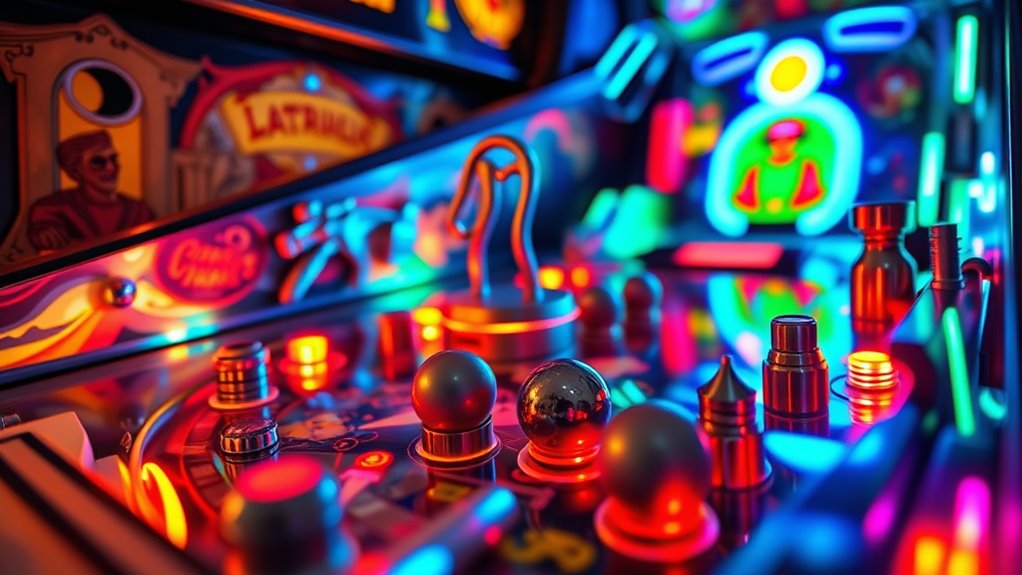
Many homebrew pinball machines stand out because their creators push the boundaries of design and engineering, turning ambitious ideas into playable realities. These projects inspire others by showcasing innovative features and craftsmanship. Imagine a machine with vivid custom artwork that transforms the playfield into a dynamic work of art. Visualize intricate sound design that immerses you in a themed experience. Envision unique mechanical elements, like custom ramps or ball guides, that challenge traditional layouts. Picture clever LED lighting that highlights game features and adds excitement. Each project demonstrates creativity and technical skill, encouraging hobbyists to experiment and improve. Incorporating legislative changes can influence how these projects are developed and shared with the community. These notable machines prove that with passion and ingenuity, homebrew pinball can rival commercial designs and captivate players worldwide.
Challenges Faced by Hobbyists in Creating Custom Machines
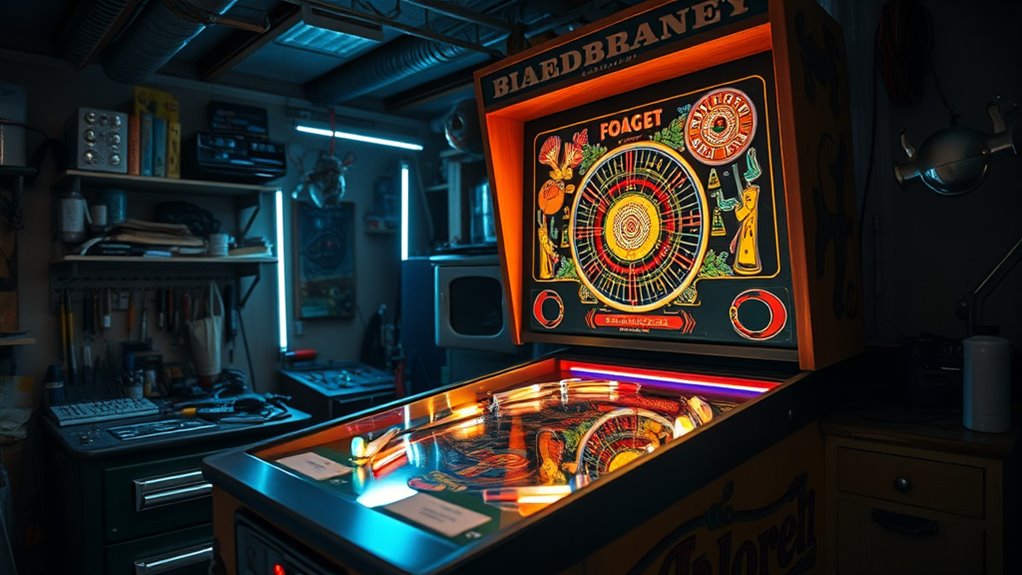
Creating a custom homebrew pinball machine presents a range of challenges that can test even the most dedicated hobbyists. One major hurdle is designing and implementing custom artwork that fits the theme and enhances visual appeal without overwhelming the playfield. Balancing aesthetics with functionality requires skill and patience. Sound integration is another significant obstacle; syncing audio effects and music seamlessly with gameplay demands technical know-how and precise programming. Limited resources and tools can make sourcing high-quality components difficult, especially for unique features. Additionally, ensuring reliable wiring and electronics to prevent malfunctions takes careful planning and troubleshooting. These challenges require perseverance, creativity, and technical expertise, but overcoming them results in a one-of-a-kind machine that reflects your vision and craftsmanship. Incorporating community engagement can also provide valuable feedback and inspiration throughout the process.
The Role of Community and Online Resources in the Revival
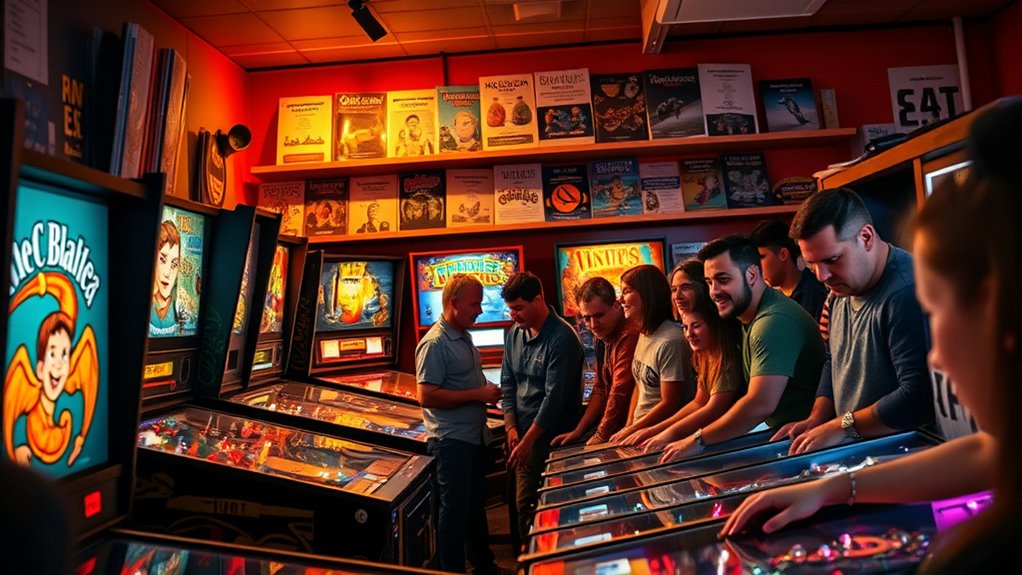
Community and online resources have become essential in fueling the revival of homebrew pinball machines, providing hobbyists with support, inspiration, and practical guidance. Online forums connect you with experienced creators, offering troubleshooting tips, design advice, and feedback. Community workshops serve as hands-on spaces where you can learn new skills, collaborate, and prototype ideas with others. Imagine:
- Sharing designs on online forums, sparking new ideas.
- Participating in community workshops, gaining technical skills.
- Receiving encouragement from fellow hobbyists facing similar challenges.
- Accessing a wealth of tutorials and blueprints that streamline your build process.
- Leveraging local resources and knowledge of regional experts to enhance your projects.
These resources create a vibrant network that keeps passion alive, making the complex process of building custom pinball machines more accessible and enjoyable.
Design Trends and Innovative Features in Modern Homebrew Pinball
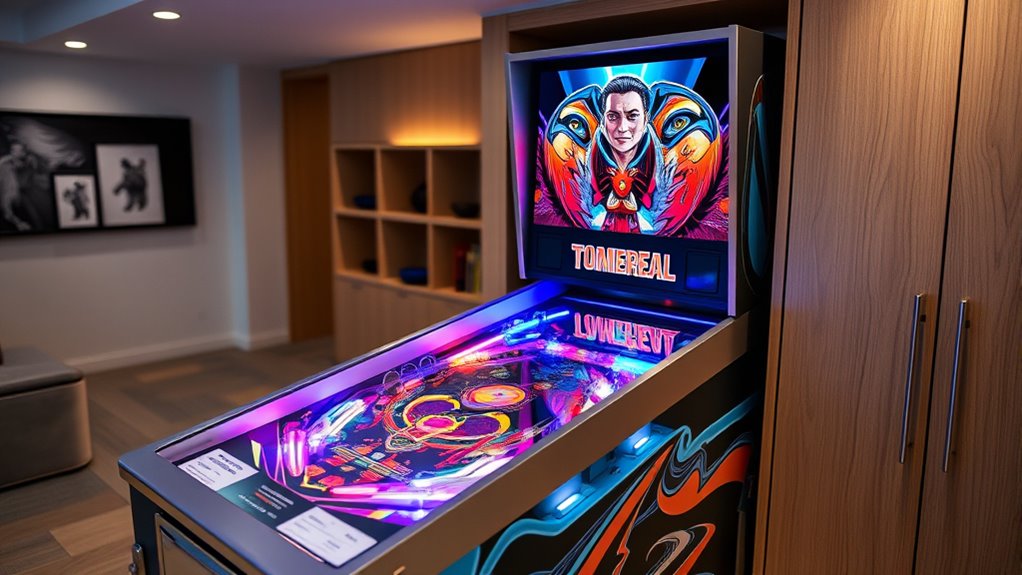
Innovative design trends are transforming homebrew pinball machines, combining modern technology with classic gameplay to captivate enthusiasts. You’ll notice custom artwork that adds vibrant, personalized visuals, making each machine unique and visually striking. Advanced sound design also enhances the experience, delivering immersive audio effects and thematic music that elevate gameplay. Modern builders incorporate LED lighting, touchscreen displays, and innovative target layouts, creating dynamic playfields that challenge and entertain. These features push the boundaries of traditional pinball design, blending nostalgia with innovation. You, as a creator or player, benefit from these trends by experiencing more engaging, personalized machines that reflect both artistic expression and technological progress. This evolution keeps the spirit of homebrew pinball fresh, exciting, and increasingly sophisticated.
How to Get Started With Building Your Own Pinball Machine

Getting started means planning your design carefully to bring your vision to life. Next, gather the necessary parts, including components and tools, to build your machine. When selecting materials, consider essential oils for respiratory health to enhance the ambiance and relaxation during gameplay. Finally, assemble and test your pinball to guarantee everything works smoothly before making adjustments.
Planning Your Design
Starting your pinball machine project begins with clear planning. You need a solid vision to guide your build. First, sketch out your game’s theme, considering custom artwork to make it visually compelling. Next, design the layout, mapping out the playfield, bumpers, and targets for engaging gameplay. Then, think about sound design—decide on sound effects and music that enhance the experience. Finally, set a realistic timeline and budget, prioritizing essential components first. Visualize your machine’s look, feel, and sound, ensuring they align with your creative goals. Proper planning helps prevent surprises and keeps your project on track. With these steps, you’ll create a unique, personalized pinball machine that reflects your style and passion.
Gathering Necessary Parts
Before you begin gathering parts for your pinball machine, it’s vital to create a detailed list of everything you’ll need. Start with core components like the playfield, flippers, and bumpers. Don’t forget to include coin mechanisms, which allow you to manage quarters or tokens, adding an authentic arcade feel. You’ll also need a reliable sound system to enhance gameplay with music, sound effects, and alerts. Consider sourcing high-quality switches and sensors for accurate scoring and responsive play. Mechanical parts like solenoids and motors are essential for moving components. For the cabinet, gather plywood, hardware, and wiring supplies. Planning your parts list carefully ensures you won’t miss essential pieces and helps keep your build organized and efficient from the start. Proper storage of components can also prevent damage and ensure longevity of your parts.
Assembling and Testing
Once you have all your parts ready, it’s time to begin assembling your pinball machine. Picture yourself fitting the custom artwork onto the cabinet, aligning every detail perfectly. Next, install the playfield, ensuring the sound design elements are wired correctly for immersive audio. As you connect the switches and sensors, visualize the intricate circuitry coming to life. Finally, test each component—checking the flippers, lights, and sound effects—making adjustments as needed. This process transforms your raw parts into a functioning machine. Keep a keen eye on the details, especially in finishing touches like artwork and sound, to guarantee your build reflects your vision. Testing is critical, so play a few rounds to verify everything runs smoothly before final assembly.
The Future of Homebrew Pinball and Its Impact on the Industry
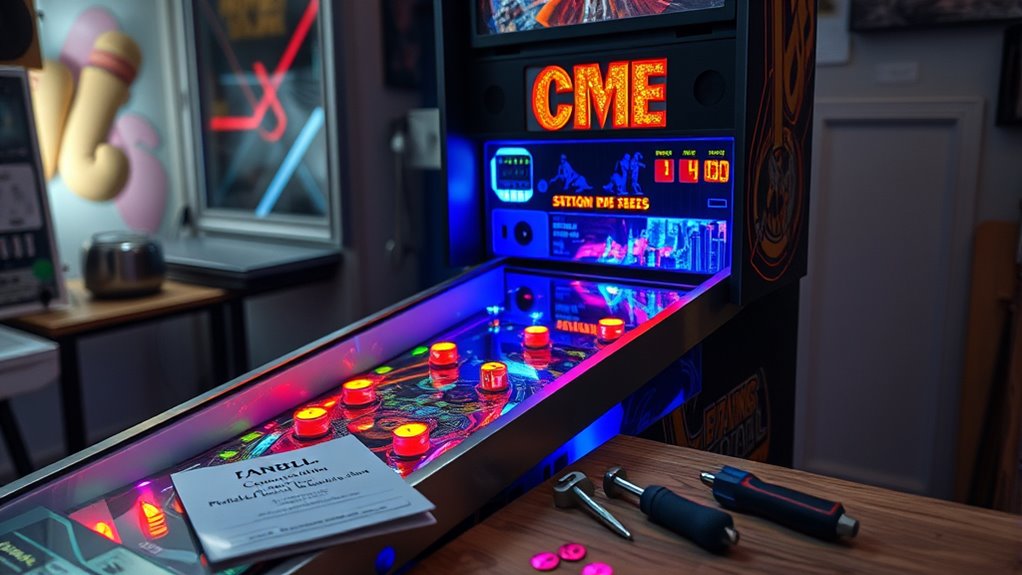
As homebrew pinball continues to evolve, it’s poised to substantially shape the industry’s future. You’ll see creators pushing boundaries with custom artwork that makes each machine unique, reflecting personal style and creativity. Sound design also plays a vital role, allowing hobbyists to craft immersive audio experiences that enhance gameplay. These innovations inspire larger manufacturers to embrace customization options, leading to a more diverse and vibrant market. As more enthusiasts share their designs and techniques, the community’s influence grows, encouraging collaboration and innovation. This synergy could redefine how pinball machines are designed and appreciated, emphasizing artistic expression and personalized experiences. Ultimately, the future of homebrew pinball will impact the industry by fostering creativity, expanding options for players, and inspiring mainstream manufacturers to explore new possibilities.
Frequently Asked Questions
What Legal Considerations Exist for Building and Operating Homebrew Pinball Machines?
When building and operating homebrew pinball machines, you need to consider legal compliance and licensing requirements. You’re responsible for ensuring your machine doesn’t infringe on intellectual property rights or violate safety standards. Check local laws related to electronic devices and gaming equipment. Obtaining necessary licenses or permits might be required, especially if you plan to sell or publicly display your machine. Staying informed helps avoid legal issues and keeps your project compliant.
How Do Homebrew Pinball Machines Differ From Commercial Ones in Gameplay?
You might think all pinball machines are the same, but homebrew versions prove otherwise. They offer custom gameplay that reflects their creator’s vision, often featuring unique features not found in commercial models. While commercial machines stick to tried-and-true designs, homebrew machines challenge convention, giving players fresh experiences. So, in a way, you’re actually playing something more personal and inventive, making each game feel like an exclusive adventure.
What Are the Most Common Mistakes Made by Beginners in DIY Pinball Projects?
When tackling DIY pinball projects, you often make mistakes like poor DIY wiring, which can cause shorts or malfunctions. You may also struggle with component sourcing, leading to delays or incompatible parts. Beginners often overlook detailed planning, rushing assembly instead of testing each step. To avoid these issues, double-check your wiring, source quality components, and follow clear instructions. Patience and thoroughness improve your chances of building a successful pinball machine.
Can Homebrew Pinball Machines Be Commercially Manufactured or Sold?
You can definitely manufacture and sell homebrew pinball machines, but you’ll need to navigate manufacturing regulations and licensing requirements. You must guarantee your machine complies with safety standards, electrical codes, and quality controls. Securing proper licensing protects your intellectual property and ensures legal sales. By following these steps, you can turn your creative design into a commercially viable product, reaching enthusiasts and collectors enthusiastic for unique, handcrafted pinball experiences.
How Do Environmental Factors Affect the Longevity of Homemade Pinball Machines?
You should consider how humidity effects and sunlight damage impact your homemade pinball machines. Excess humidity can cause wood warping and rust on metal parts, shortening their lifespan. Sunlight damage, especially from prolonged exposure, can fade artwork and degrade plastics. To protect your creation, keep it in a controlled environment, away from direct sunlight, and maintain stable humidity levels. Doing so guarantees your pinball machine stays functional and visually appealing over time.
Conclusion
Getting into homebrew pinball is like opening a secret portal to arcade greatness. With your own machine, you’re not just playing games—you’re rewriting the rules of fun, creating a legend that’ll outshine any commercial pinball. So immerse yourself, build boldly, and let your custom creation become the stuff of pinball legend. The world of DIY pinball isn’t just a hobby; it’s your ticket to eternal arcade glory!

